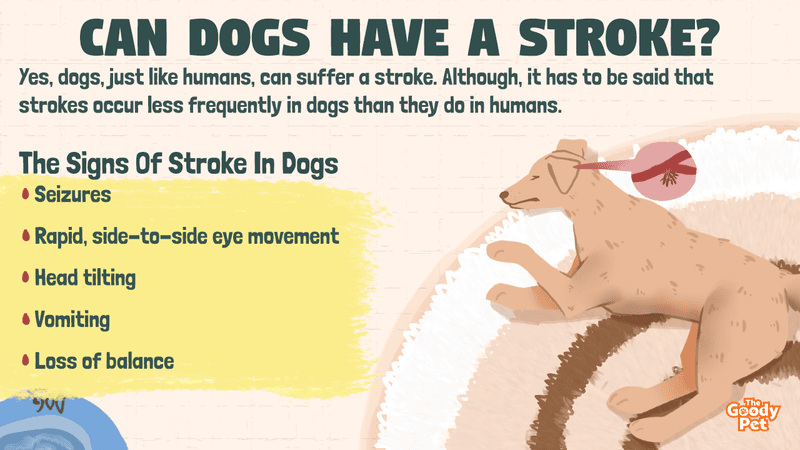Just like their human parents, dogs can suffer from a number of emergency medical conditions. However, one medical condition that dog parents aren’t aware their pooches can suffer from is stroke due to its rareness. So, can dogs have a stroke?
Yes, dogs can suffer strokes, even though strokes occur less frequently in dogs than in humans. Canine stroke is caused either by the absence or the presence of too much blood in the pooch’s brain, with both conditions depriving the dogs’ brains of much-needed oxygen. Hence, the ability to recognize stroke symptoms will save your dog’s life.
Due to the rarity of this medical condition, it can be a challenge to determine whether or not your pooch is suffering from a stroke. However, the symptoms of canine stroke that are detailed in this article are sure to give you a head-start, even though you would have to get a proper medical diagnosis to treat this medical condition.
Also, not knowing what to do while your dear Fido suffers a stroke can be a real bummer, which is why we’ve also included some practical steps you can take while your canine buddy is experiencing a stroke. However, before we delve into all this, let’s see why dogs can develop a stroke.
Can Dogs Have A Stroke?

Yes, dogs, just like humans, can suffer a stroke. Although, it has to be said that strokes occur less frequently in dogs than they do in humans.
Canine stroke is a rare medical condition that occurs when there’s a loss of proper blood flow to a pooch’s brain, which results in the development of several adverse effects.
Symptoms of canine stroke are closely related to what may be observed in humans, although for obvious reasons, dogs don’t suffer the slurred speech or memory loss associated with human stroke.
Regardless, canine stroke, also known as a cerebrovascular accident, remains a serious medical condition requiring professional medical attention.
And the fact that symptoms of a canine stroke are similar to those observed in other dog health conditions, such as inner ear infections and idiopathic vestibular disease, coupled with the rarity of the disease, is why proper medical diagnosis is needed to identify and treat cases of canine stroke.
What Dogs Are Most Likely To Have A Stroke?
All dog breeds, no matter how healthy, can suffer from a stroke. However, according to a study published by the American Animal Health Association (AAHA), pooches with a history of certain medical conditions are at a higher risk of developing a stroke.
And some of these diseases that predispose dogs to stroke include Cushing’s disease, diabetes, kidney disease, and cancer, just to mention a few.
Additionally, while canine stroke isn’t breed-specific, dog breeds, such as the King Charles Cavalier Spaniels and Greyhounds, with a high rate of heart disease, are at a higher risk of developing and suffering from strokes.
Also, as with humans, older dogs are generally at a higher risk of suffering from a stroke, but this doesn’t mean that puppies and relatively younger dogs are completely exempt from this medical condition.
What Causes Stroke In Dogs?

Canine stroke is mostly caused by obstruction of the pooch’s blood vessels or bleeding in the dog’s brain.
Obstruction Of Blood Vessels
The most common causes of strokes in dogs occur when vessels supplying blood to a pooch’s brain become blocked, either due to a narrowing or an obstruction, thereby resulting in damage to brain tissues.
This form of canine stroke is known as an ischemic stroke, and it typically results in a dog’s brain being deprived of blood and oxygen.
Ischemic stroke, due to the obstruction of a pooch’s blood vessels, occurs due to several medical conditions, with the most common examples of these health issues including:
- Hyperlipidemia, a condition which is characterized by an abnormally high concentration of fats in a dog’s blood
- An increase in blood velocity
- Clogging of arteries by tumors or parasites
- Congenital clotting diseases
- Abnormal development of blood vessels
Bleeding In The Dog’s Brain
Apart from obstruction of blood vessels, another main cause of stroke in dogs is excessive bleeding in the pooch’s brain, and this is typically referred to as a hemorrhagic stroke.
A hemorrhagic stroke typically happens due to broken blood vessels, with blood either leaking within the dog’s brain or filling the space between a pooch’s brain and skull.
Unlike ischemic stroke, which occurs as a result of a pooch’s brain being deprived of blood, hemorrhagic strokes are characterized by the presence of too much blood in a dog’s brain.
However, both the ischemic and hemorrhagic strokes in dogs are similar in the sense that they both deprive a pooch’s brain of sufficient oxygen.
That said, hemorrhagic strokes in dogs are triggered by certain medical conditions, with the most common examples being:
- High blood pressure or canine hypertension
- Trauma to the head
- Heart attack
- Toxic poisoning
- Infection of the central nervous system
What Are The Signs Of Stroke In Dogs?
Common signs of stroke in dogs include vomiting, loss of body balance and coordination, breathing difficulties, and occasional loss of consciousness.
If you’re not keeping your eyes on a pooch round the clock, it may be difficult to tell that the dog in question is suffering a stroke. There are typically no warning signs that a pooch is about to suffer a stroke, and the symptoms of strokes in dogs can go from ‘mild’ to ‘severe’ really quick.
Additionally, the fact that dogs are stoic and do not readily show pain makes it more difficult to determine whether or not a pooch is suffering a stroke.
That said, some of the signs commonly exhibited by a pooch experiencing a stroke include the following:
- Collapse and a subsequent loss of consciousness
- Seizures
- Rapid, side-to-side eye movement
- Irregular behavior, like a normally gentle dog acting aggressively
- Head tilting
- Pacing
- Vomiting
- Loss of bladder and bowel control
- Loss of balance
- Inability to walk straight

What Should I Do When My Dog Has A Stroke?
The proper course of action should be to get on the phone with a vet immediately if you notice the dog exhibiting the symptoms of a stroke to ensure your pooch’s continued safety.
Canine stroke is a delicate health situation with potentially lasting consequences for the dog, which is why prompt and proper medical attention is of the utmost importance.
Contact Your Vet Immediately
The first and appropriate course of action once you notice your pooch exhibiting the symptoms of a stroke is to immediately get on the line with your vet. Symptoms of stroke in dogs are similar to those observed when a pooch is suffering a fainting spell. And this is why a professional diagnosis is needed to properly treat stroke in dogs.
What Should I Do While My Dog Is Having A Stroke?
Here are some of the things you can do to assist your canine buddy if you happen to stumble upon the pooch suffering a stroke:
- Don’t panic; by staying calm, you can maintain a clear head and provide your pooch with the needed help.
- Keep your pooch safe and reassured by staying close while it is having a stroke.
- Speak to the dog in hushed, calm tones, and also take time to pet the pooch if it demands attention.
- If your dog is laying down, occasionally elevate the pooch’s head to prevent the development of excess pressure in the brain.
- Get the pooch to a vet as soon as possible; However, in most cases, you will need to wait until the dog is calm before you can transport it.
How Much Does It Cost To Treat Stroke In Dogs?
Given that various conditions can result in a pooch developing a stroke, the cost of treating this medical condition varies from dog to dog.
However, when treating canine stroke, there are certain basic expenses that you can expect to pay, with the overall medical bill depending on the severity of the pooch’s stroke.
A medical diagnosis of stroke in dogs, which usually involves the vet carrying out blood tests, urinalysis, and Magnetic Resonance Imaging (MRI) testing, is usually expensive, with bills running into hundreds and, sometimes, thousands of dollars!
Generally, when treating dogs suffering from a stroke, vets charge an average of $70 per day to hospitalize and observe the pooch. Also, most cases of canine stroke result in the pooch being deprived of oxygen.
Hence vets typically prescribe that the dog in question should be placed on oxygen support, and this typically costs between $120 to $130 per treatment. Urinary catheterization is often needed for dogs that can’t move independently, generally costing $45.
Vets also prescribe intravenous fluids to help hydrate dogs suffering from stroke, and this costs between $35 to $60; Larger dogs typically require more intravenous fluid, and this translates into higher costs.
In some cases, surgery may be needed to treat certain underlying health conditions responsible for a dog’s stroke. And in such cases, vet bills may run into thousands of dollars!

How Can I Prevent My Dog From Having A Stroke?
Strokes can’t be transmitted from dog to dog; hence, little to nothing can be done to directly prevent pooches from developing strokes.
However, as mentioned earlier, certain diseases place dogs at a higher risk of developing strokes; Hence, routine medical check-ups will help in diagnosing these diseases at a relatively early stage, thereby reducing a pooch’s chances of developing a stroke.





